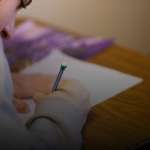Section 1
Preview this deck
parietal pericardium
Front
Active users
0
All-time users
0
Favorites
0
Last updated
4 years ago
Date created
Mar 14, 2020
Cards (109)
Section 1
(50 cards)
parietal pericardium
lines the heart (outside of pericardial cavity)
Arteries
carry blood away from the heart, thicker with more resistance
right side
Side that pumps blood into the pulmonary arteries
pulmonary semilunar valve
valve positioned between the right ventricle and the pulmonary artery; prevent back flow into the ventricles
left atrioventricular valve
aka mitral or bicuspid valve; Blood leaving the left atrium flows into the left ventricle through this valve; most commonly replaced due to more pressure on left side of the heart
Atria
ventricles
These discharge blood into vessels to leave the heart.
veins
return blood to the heart, thinner with less resistance
atria
receiving chambers of heart; receive blood
pericardial cavity
surrounds the heart.
Heart base
pulmonary circuit
carries oxygen-poor (deoxygenated) blood from the heart to the lungs and back. Right side of heart. Low pressure circulation.
P wave
atrial depolarization (activation before atrial contraction)
QRS complex
ventricular depolarization; moment before ventricles contract; atrial repolarization (overshadowed by Vent. activity)
left side
Side that receives blood from pulmonary veins; left ventricle has more thicker myocardium b/c it pumps blood to more parts of the body
Four chambers of the heart
the right atrium and right ventricle, left atrium and left ventricle.
pulmonary trunk
Blood leaving the right ventricle enters this after passing through the pulmonary valve.
coronary arteries
originate at the base of the ascending aorta, and each gives rise to two branches; deliver oxygenated blood to cardiac muscle cells (myocardial wall)
Right Coronary Artery
courses to the right side of the heart; delivers oxygenated blood to the right myocardial wall
left and right pulmonary arteries
These branch from the pulmonary trunk and carry deoxygenated blood to the lung capillaries
Endocardium
pericardial sac
surrounds the heart and helps prevent overfilling.
pericardial fluid
small amount of lubricating fluid in heart.
superior & inferior vena cava
The right atrium receives blood from the systemic circuit through these two great veins
Intercalated Discs
electrical conductors; ensure the electrical impulse causing contraction flows easily through the heart. This allows action potential to spread from cell to cell rhythmically.
myocardium
the muscular wall of the heart; cardiomyocytes.
Right atrioventricular valve
tricuspid valve; blood leaving the right atrium flows into right ventricle through this valve
visceral pericardium (epicardium)
covers the heart's outer surface (ON the surface)
Posterior interventricular sulcus
Epicardium
Capillaries
tiny vessels between the smallest arteries and veins.
Coronary Sinus
enlarged vessel on the posterior aspect of the heart that empties deoxygenated blood into the right atrium
Anterior interventricular sulcus
Auricle
left coronary artery
one of two arteries from the aorta that nourish the heart; runs from left side of heart then divides into smaller branches
heart sounds
the closure of valves and rushing of blood through the heart cause characteristic "Lub Dub" sounds that can be heard during auscultation.
interventricular septum
A thick wall that separates the right and left ventricles; walls of ventricles
AV valve (Atrioventricular)
valve which allows blood to flow from the atria to the ventricles
Apex
descending aorta
the descending part of the aorta that branches into the thoracic and abdominal aortae
Papillary Muscle
Small bunches of cardiac muscle responsible for pulling the atrioventricular valves (tricuspid & mitral) closed by means of the chord tendineae.
endocardium
the epithelium covering the inner surfaces of the heart including the valves.
Systemic Circuit
carries oxygen-rich (oxygenated) blood returning from the lungs and back to the body tissues to supply oxygen. Left side of the heart. High pressure circulation.
aortic (semilunar) valve
where blood leaving the left ventricle passes through and into the systemic circuit via the ascending aorta; prevents back flow in the ventricle.
left and right pulmonary veins
deliver oxygenated blood to the left atrium
ascending aorta
Branches off the left ventricle; carries oxygen rich blood to parts of the body above the heart
Coronary sulcus
T wave
ventricular repolarization
Myocardium
Chordae Tendinae
Fibers (heart strings) attatched to the tricuspid and mitral valve which pull it closed when papillary muscles contract, preventing back flow of blood
Section 2
(50 cards)
Qt interval
Pulmonary trunk
mitral valve
fossa ovalis
circumflex artery
Interventricular septum
ascending aorta
Semilunar valves
Atrioventricular valves
right coronary artery
right atrium
left subclavian artery
Superior vena cava
St segment
Chordae tendineae
brachiocephalic trunk
Coronary sinus
superior vena cava
Pr/pq interval
left atrium
Right coronary artery
great cardiac vein
left pulmonary artery
right ventricle
Aorta
Tricuspid valve
opening of coronary sinus
ligamentum arteriosum
Bicuspid valve
Pr/pq segment
tricuspid valve
left ventricle
left atrium
left brachiocephalic vein
left anterior descending artery
Ventricles
Papillary muscles
left common carotid artery
Pulmonary veins
Left coronary artery
right brachiocephalic vein
Cardiac veins
thoracic aorta
Pulmonary semilunar valve
aortic arch
left coronary artery
Aortic semilunar valve
right pulmonary vein
right pulmonary artery
left pulmonary vein
Section 3
(9 cards)


